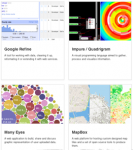Community Embraces New Word Game at Mid-Year Play Day This past Sunday, families at Takoma Park’s Seventh Annual Mid-Year Play Day had the opportunity to experience OtherWordly for the first time. Our educational language game drew curious children and parents to our table throughout the afternoon. Words in Space Several children gathered around our iPads […]
Read moreMonth: October 2012
 Most data is meaningless to most people — unless it is visualized. Stepping beyond familiar visualizations like bar charts and pie charts, there are many approaches to visualizing data, from mapping (e.g., color coding a map to show voting patterns) to visualizing networks (e.g., the links between people).
Most data is meaningless to most people — unless it is visualized. Stepping beyond familiar visualizations like bar charts and pie charts, there are many approaches to visualizing data, from mapping (e.g., color coding a map to show voting patterns) to visualizing networks (e.g., the links between people).
You are not limited to Microsoft Excel, or your own programming abilities. We’re now in an awesome generation for visualization, with dozens of freely available software libraries — which developers have spent months (or years!) building. Increasingly these use Javascript (so they work in all browsers and mobile devices). The folks at Datavisualization.ch highlight most of the best tools for making maps and charts, or processing data… (more…)
![]() It’s Open Access Week 2012. Now in it’s 6th year, the organizers are promoting Open Access as the new norm in research and scholarship. Here’s a summary of some happenings… (more…)
It’s Open Access Week 2012. Now in it’s 6th year, the organizers are promoting Open Access as the new norm in research and scholarship. Here’s a summary of some happenings… (more…)
 Games and gaming principles have a useful role in exhibit design for both real world and virtual settings. “As educators, we’re always looking for ways to make museum content ‘stickier’ and more meaningful,” says Michelle Moon in a recent blog post, “All fun and games.” Moon designs and runs public programs for adults at the Peabody Essex Museum.
Games and gaming principles have a useful role in exhibit design for both real world and virtual settings. “As educators, we’re always looking for ways to make museum content ‘stickier’ and more meaningful,” says Michelle Moon in a recent blog post, “All fun and games.” Moon designs and runs public programs for adults at the Peabody Essex Museum.
To get thinking about it, here are some simple game structures that work well for museum learning: (more…)
![]() Search the pages of America’s historic newspapers (1836-1922) with the new Chronicling America web site from the Library of Congress. Chronicling America provides access to information about historic newspapers and select digitized newspaper pages. Here are 3 newspapers from 100 years ago today: (more…)
Search the pages of America’s historic newspapers (1836-1922) with the new Chronicling America web site from the Library of Congress. Chronicling America provides access to information about historic newspapers and select digitized newspaper pages. Here are 3 newspapers from 100 years ago today: (more…)
 Undergraduate education is valuable, but expensive, averaging $375/course at a community college, and $3.5k/course at a private university. As higher education explores new business models, many are trying out free massive enrollment courses. These courses are typically not for credit (which is easier to administer and get internal approval for), and allows the schools to see what it takes chance the assumptions about delivering education. (more…)
Undergraduate education is valuable, but expensive, averaging $375/course at a community college, and $3.5k/course at a private university. As higher education explores new business models, many are trying out free massive enrollment courses. These courses are typically not for credit (which is easier to administer and get internal approval for), and allows the schools to see what it takes chance the assumptions about delivering education. (more…)
 Film and video can be compelling forms of communication — but using video in science is hard to do well. Science is complex and scientists are groomed throughout their careers to speak in a precise, measured way. Film makers, on the other hand, rarely have a graduate background in science, and they are attuned to storytelling, colorful characters and sound bites. Thus a conflict often rises between filmmakers and scientists, which is colorfully summarized by wildlife filmmaker Chris Palmer: (more…)
Film and video can be compelling forms of communication — but using video in science is hard to do well. Science is complex and scientists are groomed throughout their careers to speak in a precise, measured way. Film makers, on the other hand, rarely have a graduate background in science, and they are attuned to storytelling, colorful characters and sound bites. Thus a conflict often rises between filmmakers and scientists, which is colorfully summarized by wildlife filmmaker Chris Palmer: (more…)
 Can profits and kids mix? In a recent edSurge article, Tom Segal argues for the role of the “for-profit” entrepreneurship in the development of educational technology. Profit motives are what spur innovation at the technological level and therefore schools should look to for-profit businesses to further advancements in education-related technology. (more…)
Can profits and kids mix? In a recent edSurge article, Tom Segal argues for the role of the “for-profit” entrepreneurship in the development of educational technology. Profit motives are what spur innovation at the technological level and therefore schools should look to for-profit businesses to further advancements in education-related technology. (more…)
![]() Science journal subscriptions can cost libraries several thousand dollars a year, yet most institutions members only make use of a few articles from each of these journals. The huge subscription expenses limit how many journals each school or company can carry. Even single article pricing can be staggering, at $30-50 each. Sinisa Hrvatin, a doctoral candidate at Harvard, and his roommate Robert McGrath believe they have a better way. (more…)
Science journal subscriptions can cost libraries several thousand dollars a year, yet most institutions members only make use of a few articles from each of these journals. The huge subscription expenses limit how many journals each school or company can carry. Even single article pricing can be staggering, at $30-50 each. Sinisa Hrvatin, a doctoral candidate at Harvard, and his roommate Robert McGrath believe they have a better way. (more…)


 Getting the community involved in contributing content to an online project is a great form of public participation, and also a way to build large repositories of content. However, the underbelly of community-generated content is bad taste, inappropriate content, and outright abuse.
Getting the community involved in contributing content to an online project is a great form of public participation, and also a way to build large repositories of content. However, the underbelly of community-generated content is bad taste, inappropriate content, and outright abuse.